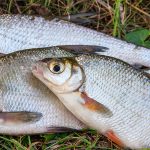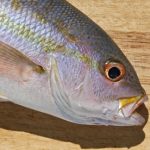1. Using the Wrong Gear for the Fish Species
One of the most common mistakes new anglers make is using fishing gear that doesn’t match the type of fish they’re targeting. Many beginners grab any rod and reel combo off the shelf, not realizing that different species require different gear setups. Using the wrong gear can make it harder to catch fish, damage your equipment, or even cause you to lose a great catch.
Why Matching Gear Matters
When your gear is too light for a big fish like a bass or pike, you risk snapping your line or breaking your rod. On the flip side, using heavy gear for small panfish makes it hard to feel bites and takes the fun out of the experience. Matching your gear to your target species not only increases your chances of success but also helps protect your equipment from unnecessary wear and tear.
Basic Gear Matching Guide
Here’s a quick guide to help you choose the right setup based on popular U.S. freshwater species:
| Fish Species | Rod Power | Reel Size | Line Weight |
|---|---|---|---|
| Bluegill / Crappie | Ultralight | 1000-2000 | 2-6 lb test |
| Bass (Largemouth / Smallmouth) | Medium to Medium-Heavy | 2500-4000 | 8-15 lb test |
| Catfish | Medium-Heavy to Heavy | 4000+ | 15-30 lb test |
| Northern Pike / Musky | Heavy | 5000+ | 20-50 lb test (braid recommended) |
| Trout (Stocked / Wild) | Light to Medium-Light | 2000-3000 | 4-8 lb test |
Tips to Avoid This Mistake
- Do your research: Look up what kind of fish are in the body of water youre planning to fish and what gear works best for them.
- Tackle shop advice: Local bait and tackle shops are great resources. Staff can suggest gear based on local conditions and species.
- Start simple: If you’re just getting started, a medium power spinning rod with 8-10 lb test line is a good all-around setup for many freshwater species.
- Avoid overkill: Don’t bring a saltwater rod for bluegill fishing—it’ll take away from the experience and likely cost you more than needed.
The right gear can make all the difference between frustration and fun on the water. Spend a little time figuring out what youre fishing for, and youll have a much better chance at landing something worth bragging about.
2. Ignoring Local Fishing Regulations
If youre just getting into fishing, its easy to get caught up in the excitement of landing your first big catch. But one major mistake new anglers often make is not taking the time to learn local fishing laws. Not knowing size limits, catch limits, or seasonal closures can lead to some pretty hefty fines—and trust us, thats a fast way to ruin a good day on the water.
Why Regulations Matter
Fishing regulations arent just there to make your life harder. Theyre designed to protect fish populations and ensure that everyone has a fair shot at enjoying the sport for years to come. Ignoring these rules can harm the ecosystem and even put certain species at risk.
Common Rules You Should Know
| Regulation Type | What It Means | Why It Matters |
|---|---|---|
| Size Limits | You can only keep fish above or below a certain length | Protects young or breeding-age fish so populations stay healthy |
| Catch Limits | A maximum number of fish you can keep per day | Prevents overfishing and ensures everyone gets a chance |
| Seasonal Closures | Certain times when fishing specific species is off-limits | Allows fish to spawn and repopulate without disturbance |
| Gear Restrictions | Limits on what kind of bait or tackle you can use | Helps avoid harming non-target species or damaging habitats |
| License Requirements | You must have a valid fishing license in most states | Keeps things legal and supports wildlife conservation programs |
How to Stay Compliant
The easiest way to avoid trouble is by checking your state’s Department of Fish and Wildlife website before every trip. Most states offer free downloadable guides, apps, or quick reference charts you can keep on your phone. Heres what you should look for:
- The species youre targeting—is it in season?
- The body of water—does it have special rules?
- The gear youre using—is it allowed?
- Your daily bag and size limits—are you within them?
- Your license—do you have the correct type for where youre fishing?
Helpful Tip:
If youre unsure about a rule, ask a local bait shop or other experienced anglers. Most folks are happy to help newbies stay on the right side of the law.
![]()
3. Poor Casting Technique
Whether youre fishing from the shore, a dock, or a boat, your casting technique plays a huge role in your success. Many new anglers struggle with getting their bait where it needs to be—either its not far enough, way off target, or lands with too much splash and scares the fish away.
Why Good Casting Matters
Fish are often found in specific spots like near structures, under overhangs, or around weed beds. If your cast cant reach those areas accurately and quietly, youre missing out on bites. A poor cast doesnt just waste time—it can spook fish and even tangle your line.
Common Casting Mistakes
| Mistake | Why It’s a Problem | How to Fix It |
|---|---|---|
| Lack of Distance | You can’t reach fish holding farther out | Use proper rod action and smooth motion for longer casts |
| Poor Aim | Your lure lands away from target zones | Practice aiming by picking targets on land or water |
| Casting Too Hard | Loud splash may scare nearby fish | Let the rod do the work—focus on timing, not force |
How to Improve Your Cast
You don’t have to be on the water to get better. Practice in your backyard or at a local park with no hook attached. Watch videos, read guides, or better yet—find a buddy who knows what they’re doing and ask for tips. Don’t worry if it feels awkward at first; muscle memory builds over time.
Quick Tips:
- Start with sidearm or overhead casts—they’re easiest to control.
- Aim for smooth motion: load the rod, release at the right moment.
- If wind is an issue, keep your casts low and tight.
The more you cast, the better youll get—and that means more fish on the line.
4. Not Paying Attention to Weather and Water Conditions
One of the most common mistakes new anglers make is heading out to fish without checking the weather or water conditions. Ignoring how factors like wind, temperature, tides, or water clarity affect fish behavior can turn a promising fishing day into a total bust.
Why Weather and Water Matter
Fish are highly sensitive to their environment. A sudden drop in temperature, a shift in wind direction, or muddy water can all impact where fish go and whether theyll bite. Successful anglers learn to read these signs and adjust their strategies accordingly.
Common Weather & Water Factors That Affect Fishing
| Condition | Impact on Fish Behavior | What You Should Do |
|---|---|---|
| Wind | Pushes baitfish and stirs up food near shorelines | Fish windblown banks or points; use moving baits |
| Temperature Drops | Slows down fish metabolism; they become less active | Slow your presentation and target deeper water |
| Tides (Saltwater) | Affects fish feeding times and locations | Fish during incoming or outgoing tides for best action |
| Water Clarity | Muddy water makes it harder for fish to see lures | Use noisy or brightly-colored lures; slow down retrieves |
Pro Tips to Stay Ahead of the Game
- Check Local Forecasts: Use apps like Windy, Weather Underground, or FishWeather before you head out.
- Understand Seasonal Patterns: Learn how different times of year affect your local fish species.
- Talk to Locals: Bait shops and other anglers often have real-time info on what’s working based on current conditions.
- Tide Charts Matter: For saltwater anglers, apps like Tides Near Me are must-haves.
By learning how to read the weather and water, you’ll not only catch more fish—you’ll waste less time wondering why they’re not biting.
5. Overlooking the Importance of Bait and Lure Choice
One of the most common rookie mistakes new anglers make is using the wrong bait or lures for the fish theyre targeting—or for the environment they’re fishing in. It’s easy to assume that any bait will work anywhere, but experienced anglers know that’s far from true.
Different fish species respond to different types of bait, and even the time of year or water conditions can affect what works best. For example, bass might go crazy over plastic worms in the summer but prefer crankbaits in cooler months. Trout might bite on live bait like nightcrawlers in a stream, while saltwater species often go for shrimp or cut bait.
Know Before You Cast
If you’re not sure what bait or lure to use, don’t guess—do your homework. A quick search online or a chat with a local tackle shop can save you hours of frustration on the water. Many local anglers are happy to share what’s currently working in their area.
Bait and Lure Guide by Environment
| Environment | Common Species | Recommended Bait/Lures |
|---|---|---|
| Freshwater Lakes | Bass, Bluegill, Crappie | Plastic worms, spinnerbaits, live minnows |
| Rivers & Streams | Trout, Smallmouth Bass | Nightcrawlers, inline spinners, salmon eggs |
| Ponds | Largemouth Bass, Catfish | Topwater frogs, stink bait, soft plastics |
| Saltwater Shoreline | Redfish, Snook, Flounder | Shrimp, cut bait, jig heads with soft plastics |
Quick Tips:
- If youre not getting bites after 20–30 minutes, switch up your bait or lure.
- Match your lure size to the size of fish youre targeting.
- Naturally colored baits tend to work well in clear water; brighter colors are better in murky water.
The key takeaway? Don’t underestimate how much your choice of bait or lure matters. By learning what works best for your target species and location, you’ll catch more fish—and enjoy your time on the water a whole lot more.


